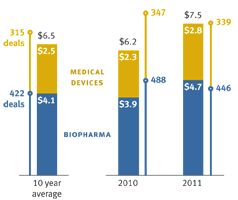Trends in Terms of U.S. Life Science Venture Financings
(Full Year 2011)
Survey Introduction and Background
For the past ten years, Fenwick & West has published a quarterly survey of trends in the valuations and terms of venture financings in Silicon Valley. A copy of the most recent version of that survey is available here.
Beginning this year, we have decided to publish a separate survey of biopharmaceutical and medical device companies ("life science") companies. We believe a separate survey focusing on life science companies will better highlight issues and trends that are affecting the life science industry differently than other industries.
One reflection of these differences is the trend in valuation, as measured by average round-to-round price change, for life science venture financings. As shown in the graph below, price change trends for life science venture financings were broadly similar to information technology industries prior to the 2008-2009 recession, but have been following a different trajectory more recently.
Average Round-to-Round Price Change by Industry
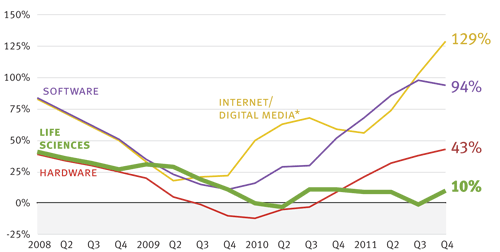
Source: Trend lines are based on four-quarter moving average of price change for Silicon Valley financings, as measured by the Fenwick & West Venture Capital Barometer. For further description of the Barometer see "Notes on Methodology" at end of this survey.
* Note: Internet/New Media and Software results were tracked together as a single category until 2009.
In compiling this survey we elected to include financings occurring throughout the United States in order to increase the number of data points. This survey reflects our analysis of the terms of venture financings for 338 life science companies headquartered in the United States that reported raising money during 2011. The results are summarized below.
Key observations and highlights from our survey include the following:
| 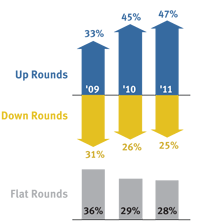 Direction of Price Change, 2009-11 | |
Detailed results from our survey begin on page 8. Where numeric data is not directly in the graphs in our detailed results, it is provided separately in an appendix to this report available online here. | ||
Overview of Third Party Industry Data
Industry data from third party sources indicate a mixed venture financing environment for life science companies during 2011. The dollar amount of equity investment into venture-backed companies in 2011 was above 2010 levels. However, the number of deals was down from 2010, and there was a step down in the number of early stage financings. In addition, 2011 marks a third year of relatively low levels of overall fundraising by venture capitalists. The life science exit environment for 2011 was similar to 2010, although IPO activity was somewhat lower than 2010.
Detailed results from third-party publications are as follows:Venture Capital Investment
- The amount of life science investment increased from 2010 to 2011, but the number of deals decreased.
- Medical device investment outpaced biopharmaceuticals in 2011 according to VentureSource. However, The MoneyTree Report showed the medical device and biotechnology sectors increasing approximately equally.
According to Dow Jones Venture Source ("VentureSource"), equity investments in U.S. venture-backed life science companies totaled $7.2 billion across 592 deals during 2011, a 10.7% increase in dollars and 4.7% decrease in deals over the $6.5 billion invested in 621 deals reported for 2010. The VentureSource results for 2011 varied across industry sectors, with medical device investment in dollars up 27.5% from 2010, as compared to biopharmaceutical investment which was flat with 2010. | 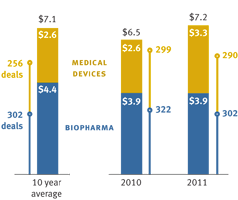 | |
| VentureSource Results |
| Similarly, the PwC/NVCA MoneyTree Report based on data from Thomson Reuters ("The MoneyTree Report") reported that investments in venture-backed life science companies totaled $7.5 billion across 785 deals in 2011, a 21.3% increase in dollars and 6.0% decrease in deals over the $6.2 billion invested in 835 deals reported in 2010. However, The MoneyTree Report showed somewhat different results by industry sector, reporting a 19.5% increase in medical device investment in dollars and a 22.4% increase in biotechnology investment for 2011. | |
| The MoneyTree Results |
Overall, the 2011 results from VentureSource and The MoneyTree Report suggest that the life science venture investment environment remains uncertain. The dollar amounts and numbers of deals reported for 2011 are above the averages over the last decade (as shown in the graphs above), although markedly below the levels reached during 2007 and 2008. However, both VentureSource and The MoneyTree Report showed a slight decrease in the number of life science deals for 2011. In addition, several industry commentators have noted that the 2011 data reflect a notable decrease in "first round" (initial) venture financings, with The MoneyTree Report showing 153 first round financings of life science companies during 2011, as compared to a historical average of approximately 200 per year over the last decade.
Corporate venture capitalists participated in 15% of the deals and invested 7% of the dollars in the life science sector during 2010 and 2011, according to data published by Thomson Reuters and the National Venture Capital Association ("Thomson/NVCA"), with participation remaining relatively constant from 2010 to 2011 and weighted more heavily toward biotechnology deals.
Silicon Valley and New England accounted for 30% and 19%, respectively, of nationwide life science venture capital investments, according to The MoneyTree Report.
Merger and Acquisition Activity
- Biopharmaceutical M&A activity for 2011 was generally in line with 2010 results. Third party sources reported differing results for medical device M&A during 2011.
- Overall M&A activity for venture-backed companies, measured across all industries, increased in dollar terms from 2010 to 2011, but there were fewer deals.
In biopharmaceutical sector M&A, Dow Jones reported 34 acquisitions of U.S. venture-backed companies during 2011, generally flat with the 32 acquisitions reported for 2010. Similarly, quarterly press releases from Thomson/NVCA reported 21 biotechnology acquisitions for 2011 as compared to 22 for 2010 (based on quarterly press releases). The HBM Partners Pharma/Biotech M&A Report ("HBM Report"), which reports on deal value for sales of North American and European biopharma companies, showed 18 sales of U.S. VC-backed biopharma companies for $3.7 billion in upfront payments ($6.2 billion total) during 2011, as compared to 19 sales for $1.7 billion upfront ($3.5 billion total) during 2010.
In medical device sector M&A, Dow Jones reported 26 medical device acquisitions of U.S. venture-backed companies during 2011, which is a decrease from the decade-high 39 acquisitions reported in 2010, but in line with the average over the past five years (~26 acquisitions per year). In contrast, Thompson/NVCA reported 46 medical device and healthcare acquisitions in 2011, up from 31 acquisitions reported in 2011. Note, however, that the Thompson/NVCA numbers include results for healthcare IT and services companies (which are not reported separately from medical device companies), which may partially account for the difference with Dow Jones results.
Dow Jones, Thompson/NVCA and the HBM Report all noted a decrease in biopharmaceutical M&A activity during the second half of 2011. Reported medical device M&A activity did not show the same decrease for the second half of 2011.
For comparison, acquisitions of U.S. venture-backed companies, measured across all industry sectors, totaled $46.3 billion in 460 deals for 2011, a 28% increase in dollar terms but a 11% decrease in number of deals as compared to 2010, according to Dow Jones. A similar decrease in the number of deals was reported by Thomson/NVCA, who reported 429 M&A transactions for 2011, as compared to 436 for 2010.
Significant acquisitions of U.S. venture backed life science companies during 2011 included Ardian (acquired by Medtronic in January 2011), Plexxikon (acquired by Daiichi Sankyo in April 2011) and Advanced BioHealing (acquired by Shire in June 2011).
Initial Public Offerings
- Life science IPOs decreased somewhat in 2011 compared to 2010, with activity falling off during the second half of 2011.
- The overall IPO market for venture-backed companies, measured across all industries, was approximately even from 2010 to 2011.
Dow Jones reported that 10 U.S. venture-backed life science companies went public in 2011 (9 of which were on U.S. exchanges), raising $0.7 billion, a decrease from 14 IPOs raising $1.0 billion in 2010. The IPO market for venture-backed life science companies softened in the second half of 2011, with only 3 IPOs on US exchanges occurring during the second half of the year, although the Clovis Oncology IPO in November 2011 (the third largest IPO of Q4, behind Groupon and Zynga) represented a notable bright spot.
Similarly, Thompson/NVCA reported that 13 U.S. venture-backed life science companies went public in 2011, raising $1.0 billion, a decrease from 17 IPOs raising $ 1.3 billion in 2010. As noted above, however, the Thompson/NVCA numbers include results for healthcare services companies (which are not reported separately from medical device companies), which may partially account for the difference with Dow Jones results.
For comparison, the IPO market for venture-backed companies, measured across all industry sectors, was even with 2010 for number of offerings, with a total of 45 IPOs in 2011 as compared to 46 in 2010, based on data reported by Dow Jones. Total dollars raised in IPOs increased from $3.25 billion in 2010 to $5.36 billion in 2011, although two exceptionally large IPOs (Groupon and Zynga) in Q4 accounted for $1.7 billion of the 2011 total.
We also note that the increased level of secondary market activity in the internet and IT sectors (which has somewhat offset the more constrained IPO and M&A markets that have prevailed since 2008) does not appear to be benefiting life science companies. For example, SecondMarket does not report any significant trading in life science companies. In contrast consumer internet companies accounted for 61% of SecondMarket transactions.
Venture Capital Fundraising
Dow Jones reported that U.S. venture capital funds raised $16.2 billion in 2011, a slight increase from the $15.4 billion raised in 2010, but still less than half the average of $33.3 billion per year raised during 2006 through 2008. Similarly, Thomson/NVCA reported that U.S. venture capital funds raised $18.1 billion in 2011, an increase from the $13.8 billion raised in 2010.
Overall, 2011 represents the fourth year in a row in which venture capital fundraising is below the amount of investment into venture-backed companies. Anecdotal evidence indicates that life science venture capitalists have been hit particularly hard by this trend, with several long-standing firms restructuring their activities or ceasing investments entirely.
A 2011 study by the NVCA (the "2011 Vital Signs Report") indicates that of venture capital firms investing in the healthcare sector, approximately 40% planned to make fewer life science investments over the next three years, whereas only 22% planned to increase medical device investments and only 14% planned to increase biopharmaceutical investments.
Regulatory Approvals
The FDA approved 30 new drug applications (NDAs) during 2011, an increase from the 21 approved in 2010 and the highest number of approvals since 2004. While the increase in NDAs approved is a positive development, it remains to be seen whether it represents a longer-run trend. We note that the 2011 Vital Signs Report cited FDA regulatory concerns as the most significant factor affecting venture capitalists' investment decisions and a leading reason for shifting activities outside of the U.S.
Nasdaq
The Nasdaq Composite (IXIC) decreased 1.8% during 2011. In contrast, the Nasdaq Biotech Index (NBI) increased 11.8% during 2011, and the broader Nasdaq Healthcare Index (IXHC) increased 4.5% over the year.
DETAILED FENWICK & WEST RESULTS
Valuation – Direction of Price Change
Up rounds outpaced down rounds for all quarters during 2011, with a substantial number of flat rounds in each quarter. This is similar to the pattern from our 2010 Silicon Valley life science results, but represents an improvement from 2009, in which down rounds exceeded up rounds during several quarters.
Results from this survey and our Silicon Valley survey indicate that flat rounds occur more often in life science deals, as compared to other industry sectors. This may in part be due to a higher percentage of inside-led financings. For example, among 2011 deals included in this survey and our Silicon Valley survey where VentureSource reported on the status of the lead investor, 52% of nationwide life science deals were inside-led, in comparison to 38% of Silicon Valley non-life science deals, and flat rounds occurred twice as frequently among the inside-led deals.
Direction of Price Change
Percentage of deals in which the direction of price change was up, down or flat
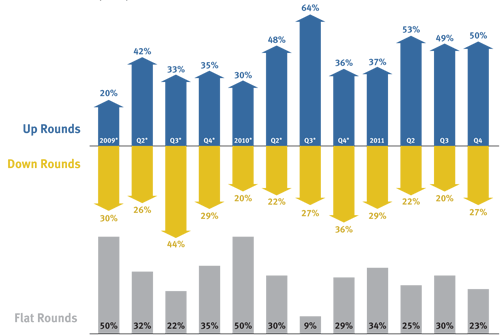
Note: in some cases results may sum to less than 100% due to rounding.
* Includes data from Silicon Valley companies only, so reflects fewer data points than 2011 nationwide results.
Valuation – Magnitude of Price Change (Barometer)
The Fenwick & West Life Science Venture Capital Barometer™ showed an average price increase for all four quarters of 2011, which represents a slight improvement over comparable 2010 and 2009 data for Silicon Valley life science companies. The trend in life science Barometer results has remained relatively flat since 2009, however, and continues to be below the target rates of return typically sought by venture capital investors. (For an explanation of how the Barometer is calculated, see "Notes on Methodology" at the end of this survey.)
The graph immediately below shows the average percentage change between the price per share at which companies raised funds in a given period, compared to the price per share at which such companies raised funds in their prior round of financing, which is a calculation we refer to as the Fenwick & West Life Science Venture Capital Barometer. Subsequent graphs show a four-quarter moving average of Barometer results and results by series of financing.
Fenwick & West Life Science Venture Capital Barometer™
Average percentage change in per share price for companies raising financing during the quarter
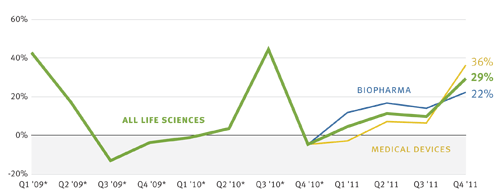
* Includes data from Silicon Valley companies only, so reflects fewer data points than 2011 nationwide results.
Separate biopharma and medical devices results not reported prior to 2011 due to smaller data set.
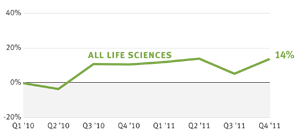
Barometer Results by Series of Financing
Average percentage change in per share price for companies raising financing of a given series during the quarter
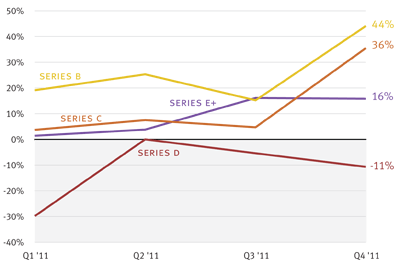
Financing Rounds Included in Survey
The financing deals covered by this survey broke down by series as shown in the graph below.
Financing Rounds Surveyed
Detail on proportion of deals included in survey from each financing round
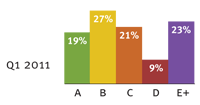 | 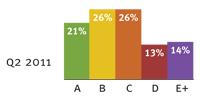 |
 |  |
Terms – Liquidation Preference
Senior liquidation preferences appeared in a substantial portion of life science deals, and were more frequent in later rounds of financing. Participation rights were also common, appearing in an average of 61% of life science deals during 2011, and uncapped in an average of 68% of the deals in which they are used.
The following graphs show the percentage of deals in which senior liquidation preferences were used, both overall and by series of financing.
Senior Liquidation Preferences
Percentage of deals involving senior liquidation preferences
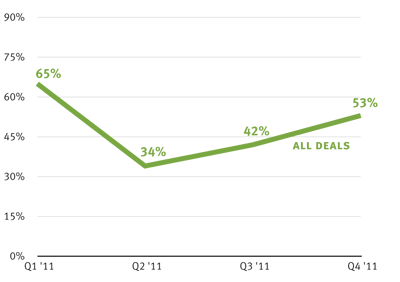
Senior Liquidation Preferences by Series
Percentage of deals of a given series involving senior liquidation preferences
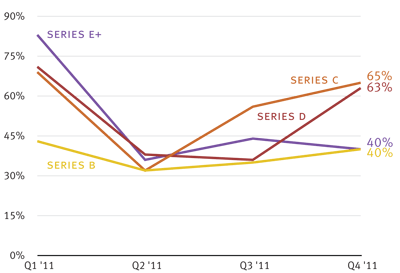
The following graph shows the percentage of deals involving senior liquidation preferences in which the preference was a multiple of the investors' purchase price. The color bands indicate the proportion of multiple liquidation preference deals in which the total preference was 1-2x, 2-3x or greater than 3x the investors' purchase price.
Multiple Preferences
Percentage of senior liquidation preference deals involving multiple preferences
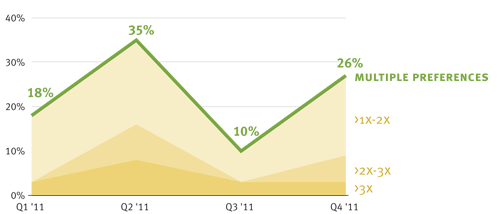
The following graph shows the percentage of deals involving participation rights. The color bands indicate the proportion of participation right deals in which the participation rights were capped (i.e., limited to a specific multiple of liquidation preferences or other amount) and uncapped.
Participation Rights in Liquidation
Percentage of deals involving participation rights
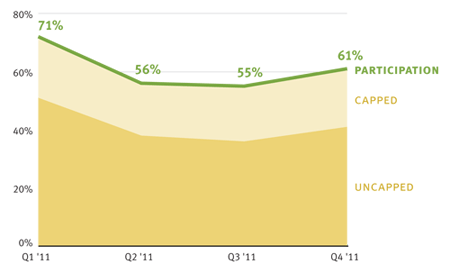
Pay-to-play provisions appeared in an average of 18% of life science deals during 2011, with some variation from quarter to quarter. Most pay-to-play provisions provided for conversion to common stock, as opposed to a shadow series of preferred stock.
Note that anecdotal evidence indicates that companies are increasingly using contractual "pull up" provisions instead of charter-based "pay to play" provisions. These two types of provisions have similar economic effect but are implemented differently. The results below include some, but likely not all, pull up provisions, and accordingly may understate the use of these provisions.
The following graph shows the percentage of deals involving pay-to-play provisions. The color bands indicate the proportion of pay-to-play provisions that involve conversion to common stock and shadow preferred stock.
Pay-to-Play Provisions
Percentage of deals involving pay-to-play provisions
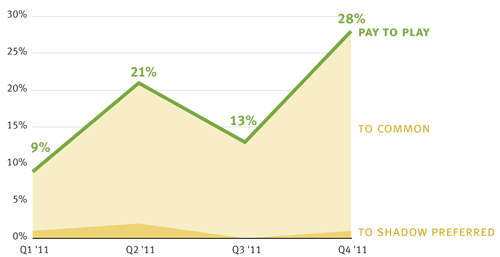
Terms – Other Provisions
Cumulative dividends and redemption rights appeared in an average of 30% and 44%, respectively, of life science deals during 2011. Anti-dilution provisions were predominantly weighted average.
Cumulative Dividends
Percentage of deals involving cumulative dividends
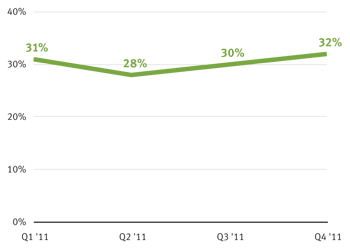
Redemption Rights
Percentage of deals involving mandatory redemption or redemption at the option of the investor
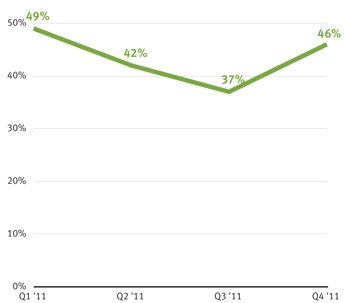
Antidilution Provisions
Percentage of deals involving weighted average, full ratchet or no antidilution
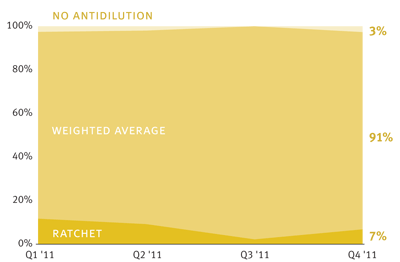
Corporate Reorganizations
Percentage of post-Series A financings involving a corporate reorganization
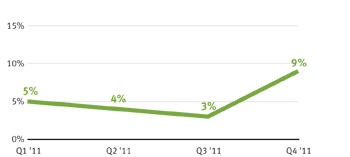
Terms – Regional and Industry Variations
In comparing results from this nationwide life sciences survey to results from our Silicon Valley survey, we observed several notable variations in the frequency of certain financing terms. In particular,
Senior liquidation preferences and pay-to-play provisions are significantly more common in life sciences deals as compared to non-life sciences deals. This is consistent with the fact that, in comparison to other industries, life science companies typically need to raise more capital over longer periods of time.
Senior Liquidation Preference Pay-to-Play Provisions 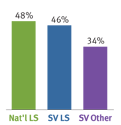

- Participating preferred stock is used frequently in life science deals, and more frequently still outside of Silicon Valley. The frequency of uncapped participating preferred follows a similar trend.
Participating Preferred Stock Uncapped Participation 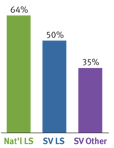
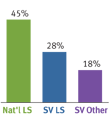
- Cumulative dividends and redemption rights are significantly more common outside of Silicon Valley, but within Silicon Valley are no more common in life sciences deals than in other industries.
Cumulative Dividends Redemption Rights 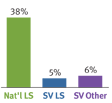
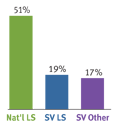
Notes on Methodology
For purposes of this survey, we use the term "life sciences" to refer to companies operating in the traditionally FDA-regulated biopharmaceutical and medical device sectors. We recognize that companies operating in adjacent sectors such as healthcare IT or biofuel production also comprise part of the life sciences industry, broadly defined. But because companies in these sectors are subject to different regulatory requirements and business conditions, and often are funded by venture capital firms that do not participate in the biopharmaceutical and medical device sectors, we have elected to exclude these companies from the survey to provide more comparable and relevant results.
The Fenwick & West Life Science Venture Capital Barometer™ measures the average percentage change between the price per share at which companies raised funds in a given period, compared to the price per share at which such companies raised funds in their prior round of financing. In calculating the average, all rounds (up, down and flat) are included, and results are not weighted for the amount raised in a financing. When interpreting the Barometer results please bear in mind that the results reflect the average price increase of companies raising money in a given quarter compared to their prior round of financing, which was in general 12‑18 months prior. Given that venture capitalists (and their investors) generally look for at least a 20% IRR to justify the risk that they are taking, and that by definition we are not taking into account those companies that were unable to raise a new financing (and that likely resulted in a loss to investors), a Barometer increase in the 30-40% range should be considered optimal.
About the Firm
Fenwick & West provides comprehensive legal services to technology and life sciences clients of national and international prominence. Fenwick is committed to providing innovative, cost-effective and practical legal services that focus on global technology industries and issues. The firm was ranked as a "Top Technology & Life Sciences Law Firm" by InterContinental Finance Magazine in its 2011 Highly Commended Top Tier Firm listing. We have built internationally recognized practices in a wide spectrum of tax, litigation, corporate and IP areas, all focused on the unique business needs of emerging and established companies, investors and research institutions. Over 40% of the attorneys in our life sciences group have advanced degrees in disciplines such as molecular biology, organic chemistry, electrical engineering and immunology, as well as business or research experience prior to their legal careers. Fenwick attorneys differentiate themselves by having a deep understanding of our clients' technologies, industry environments and business needs.
Disclaimer
The preparation of the information contained herein involves assumptions, compilations and analysis, and there can be no assurance that the information provided herein is error-free. Neither Fenwick & West LLP nor any of its partners, associates, staff or agents shall have any liability for any information contained herein, including any errors or incompleteness. The contents of this report are not intended, and should not be considered, as legal advice or opinion.
Contact/Sign Up Information
For additional information about this report please contact Matt Rossiter at 415-875-2372 | mrossiter@fenwick.com, Barry Kramer at 650-335-7278 | bkramer@fenwick.com or Michael Patrick at 650-335-7273 | mpatrick@fenwick.com at Fenwick & West.
To be placed on an email list for future editions of this survey please go to our Life Science Survey sign up page.
